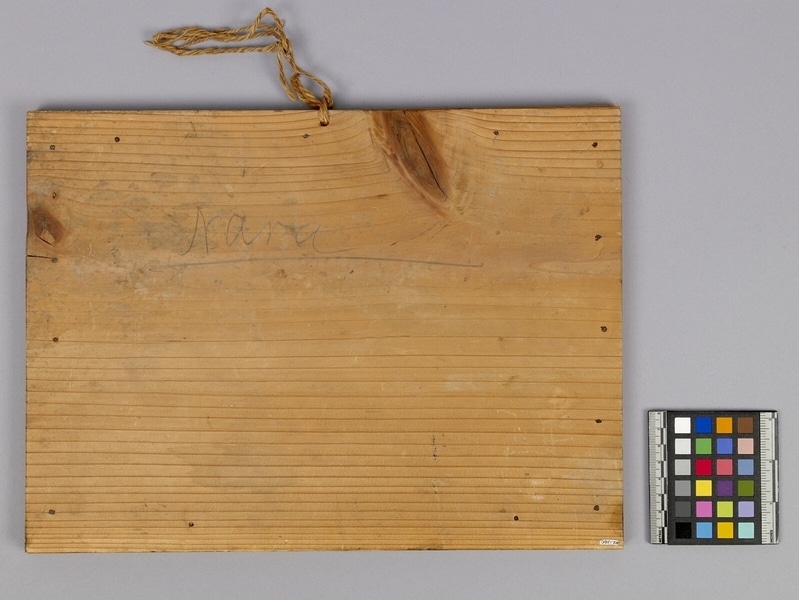Votive Plaque Item Number: N2.1360 from the MOA: University of British Columbia


Description
Painted wooden votive plaque known as ema (絵馬) with a thin sheet of paper adhered to the face, on which is painted a scene of a women with a baby and another woman with a child praying in front of a shrine. Around the ema has with several Japanese characters in black. The top reads 奉納 (hōnō; offering); the left has the date, 大正七年十一月二十七日 (November 27, Taisho 7 or 1918); the right has the name of the location and person, 南城戸 (Minami Jōdo) 藤村セイ (Fujimura Sei); the bottom appears to list the age, or ages. The back has “Nara” written in pencil.
History Of Use
The history of ema (絵馬) can be traced back to the eighth century. Historically, ema were offered to a shrine, for example, to wish for a good harvest. Nowadays, they are offered to Shinto shrines or Buddhist temples as votive plaques where worshippers write down their wishes or thanks to the deities. There are two kinds of ema: koema (小絵馬) and ōema (大絵馬). Koema are the small size ema which are offered by members of the general public, either in fulfillment of a vow or as an entreaty to a deity for help in achieving an objective or rectifying some unfortunate condition. Ōema are the large ema displayed in conspicuous locations in shrines or temples and focus more on the artistic representations.
Cultural Context
religious
Iconographic Meaning
Ema (絵馬) contains two characters: e (絵) is the picture or pictorial representation; ma (馬) is horse. The horse in Shinto serves not only as a vehicle for various gods, but also as a messenger between the temporal and celestial worlds. People used the horse representation on the wooden plaque to draw or write their wishes, so that the horse carries their wishes to deities of Shinto or kami (神).
Item History
- Made in Nara, Japan during 1918
- Owned by Union College before 1960
- Received from Union College (Donor) during 1960
What
- Name
- Votive Plaque
- Identification Number
- N2.1360
- Type of Item
- plaque
- Overall
- height 26.7 cm, width 36.2 cm, depth 1.7 cm
Who
- Culture
- Japanese
- Previous Owner
- Union College
- Received from
- Union College (Donor)
Where
- Holding Institution
- MOA: University of British Columbia
- Made in
- Nara, Japan
When
- Creation Date
- during 1918
- Ownership Date
- before 1960
- Acquisition Date
- during 1960
Other
- Item Classes
- paintings
- Condition
- fair
- Current Location
- Case 79
- Accession Number
- 1813/0011